As an avid kayaking enthusiast, I have had the pleasure of gliding across serene lakes, navigating winding rivers, and even braving the occasional white-water rapids. Over the years, kayaking has become more than just a hobby for me; it’s become a way to connect with nature, recharge my batteries, and challenge myself both physically and mentally. But I must admit, the first time I set foot in a kayak, I was filled with a mix of excitement and trepidation. One question weighed heavily on my mind: “Do kayaks tip easily?”
It’s a common query among beginners and even intermediate paddlers, a natural concern for anyone who wishes to avoid an unplanned swim in the often chilly water. Furthermore, feeling confident in your ability to control and maintain the stability of your kayak is essential for a safe and enjoyable experience. And so, in this article, we will dive into the facts and factors that affect kayak stability, as well as provide tips and expert insights to help you stay upright and at ease while exploring the world of kayaking.
Contents
Contents
Understanding Kayak Stability

One of the most important factors contributing to a kayak’s stability is its hull design. Kayak hulls come in various shapes and styles, each offering specific advantages. Here’s a breakdown of some kayak stability concepts and hull designs to consider:
Primary And Secondary Stability
Primary stability, also known as initial stability, refers to how stable the kayak feels when it’s resting flat on the water’s surface. Kayaks with a flatter hull design tend to have better primary stability, making them suitable for beginners and leisurely paddling conditions.
On the other hand, secondary stability refers to the kayak’s stability when it’s tipped to one side or tilted. Kayaks with a rounder hull design generally have better secondary stability, enabling them to perform well in choppy water and rough conditions.
Hull Design And Shapes
There are three main types of hull configurations that determine kayak stability:
- Flat: Flat hulls offer excellent primary stability, making them ideal for calm water, recreational kayaking, and beginners. They are also well-suited for fishing due to their stability.
- Rounded: Rounded hulls provide enhanced secondary stability and allow for quicker maneuvers. These kayaks are more suited for intermediate and advanced paddlers tackling choppier waters.
- V-shaped: V-shaped hulls offer great secondary stability, making them suitable for long-distance paddling and choppy conditions. These kayaks usually track well and cut through the water efficiently but may not be as beginner-friendly as flat hulls.
Different Types Of Kayaks And Their Stability
Not all kayaks are built equally when it comes to stability. Here are the general characteristics of some common kayak types:
- Recreational Kayaks: These kayaks are designed with flatter hulls, wide beams, and excellent primary stability to cater to beginners and leisure paddlers.
- Touring Kayaks: With their longer lengths and sleeker shapes, touring kayaks generally have better secondary stability while still maintaining fair primary stability. They are built to handle rougher conditions and longer paddling expeditions.
- Whitewater Kayaks: Made for navigating rapids and extreme water conditions, whitewater kayaks have a hull design that emphasizes secondary stability and maneuverability.
- Fishing Kayaks: Designed specifically for angling, fishing kayaks usually boast superb primary stability, allowing for anglers to stand and cast without fear of tipping over. They may also come equipped with wide beams and flat hulls.
Understanding kayak stability, types, and hull designs can set you on the right path as you choose the kayak that best suits your paddling preferences and skill level.
Factors That Affect Kayak Stability

Several factors contribute to a kayak’s stability, making it essential for paddlers to understand these aspects when selecting and maneuvering their kayak. Recognizing these factors can be the key to a safe and enjoyable experience on the water.
1. Weight Distribution And Capacity
One of the most crucial factors affecting kayak stability is proper weight distribution. A kayak with a higher weight capacity will generally be more stable than a lower-capacity kayak, especially when paddling in rough waters. Knowing your kayak’s maximum weight limit and maintaining an even weight distribution on the boat will significantly impact your kayak’s stability and overall safety.
2. Paddler’s Skill And Experience
The paddler’s skill level and experience can significantly impact a kayak’s stability. Experienced kayakers have honed their balance, acquired efficient paddling techniques, and developed a better understanding of their kayak’s capabilities. On the other hand, beginner paddlers might struggle initially with stability, but practicing and developing their skills can quickly improve their kayak stability and comfort on the water.
3. Water Conditions And Weather
The conditions of the water and the weather can have a considerable effect on a kayak’s stability. Calm waters are naturally easier to paddle, but facing currents, waves, and windy conditions can challenge your kayak’s stability. As a paddler, you must learn to adapt to these changing conditions to maintain control and prevent your kayak from tipping.
4. Proper Outfitting And Seating Position
A kayak’s outfitting and proper paddler’s seating position can also influence its stability. Maintaining a lower center of gravity, adjusting the footpegs and seat correctly, and ensuring that your back and hips are well-supported will go a long way toward improving the stability of your kayak. Additionally, the correct outfitting, including thigh braces and hip padding, can provide better control and maneuverability during more advanced kayaking situations.
Tips For Preventing A Kayak From Tipping
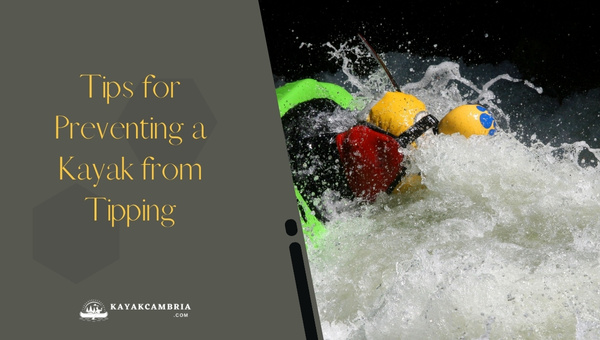
Preventing a kayak from tipping is essential for a fun and safe outing on the water. By mastering a few techniques and being conscious of your body movements while kayaking, you can significantly reduce the risk of capsizing. Here are some key tips to help you keep your kayak upright.
1. Mastering The Low Brace And High Brace Techniques
The low brace and high brace are fundamental paddling techniques that help you maintain stability while kayaking in rough or unpredictable conditions. Both techniques involve using your paddle as a support against the surface of the water to regain balance and prevent the kayak from tipping. The difference is, in the low brace, your paddle blade lies flat on the water with the knuckles up; while in the high brace, the blade is also flat on the water, but the knuckles are facing down.
2. Learning To Lean Into The Turns
When you’re navigating around obstacles or making sharp turns in your kayak, there’s a natural tendency to lean away from the turn, which may result in the kayak becoming unstable. Instead, it would help if you practiced leaning into the turn to provide improved stability. This intentional body movement helps to keep your weight centered over the boat and keeps it stable during the turn.
3. Conditioning And Developing Core Strength
Strong core muscles are crucial for maintaining balance and stability in a kayak. Your core muscles help control the motion of the kayak through your hips when paddling and can prevent you from unintentionally leaning too far in one direction. Integrating core exercises into your fitness routine, such as planks or boat poses, can significantly improve your balance and control while kayaking.
4. Practicing Edging Techniques
Edging refers to intentionally tilting your kayak on one side to aid in turning or to counteract the effect of wind and waves. To master edging, you need to shift your body weight and use your hips to control the boat’s tilt, all while keeping your upper body upright. Regularly practicing this technique can help improve your overall stability while kayaking.
5. Proper Body Positioning
Lastly, always remember to maintain proper body positioning when kayaking. Sit upright with your back against the seat, place your feet securely on the foot braces, and keep your knees bent slightly outwards to maintain contact with the kayak’s sides. Maintaining good posture not only reduces fatigue and discomfort but also allows you to be more in control of your boat as you navigate through the water.
By following these preventive measures, you’ll be well on your way to reducing the risk of tipping your kayak and ensuring a much more enjoyable paddling experience.
How To Recover From A Kayak Capsize?
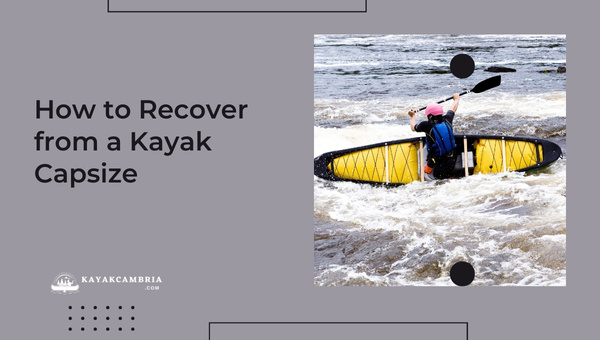
In the world of kayaking, capsizing is a natural and sometimes inevitable part of the experience. Knowing how to recover from a capsize can help you regain control and continue enjoying your time on the water. Here, I’ll share with you some essential techniques and tips to make your recovery process swift and seamless.
1. Assess The Situation And Stay Calm
The first step when capsizing is to stay calm and composed. Take a deep breath and assess the situation. Keep your focus on the surface of the water and think about your next moves. Remember, panicking will only make things worse, and having a clear mind is critical in dealing with a capsize situation.
2. Wet Exit And Wet Re-entry Techniques
If you become upside down in your kayak, first attempt the Eskimo roll technique to right yourself. However, if you are unable to roll up or you’re paddling a sit-on-top kayak, you’ll need to perform a wet exit and re-entry. Lean forward and push yourself out and away from the kayak. Once you’re out, ensure that you keep hold of your paddle and stay near your kayak.
After the wet exit, you’ll perform a wet re-entry. The re-entry techniques may vary depending on the type of kayak you’re using, but generally, you’ll need to position yourself next to your capsized kayak, flip it upright, and climb back in or re-attach your spray skirt if you’re using a sit-inside kayak. You may also use an assisted rescue technique if necessary.
3. Use Self-Rescue And Assisted Rescue Techniques
Self-rescue techniques are helpful if you’re paddling alone and need to recover from the capsize. The most common self-rescue is the paddle float re-entry. For this technique, you’ll need a paddle float and a bilge pump. First, inflate the paddle float and attach it to the end of your paddle. Then, hold on to the paddle and the kayak’s cockpit while using the opposite end of the paddle as leverage to hoist yourself back into the kayak. Once you’re back in, use the bilge pump to remove any water that may have entered.
An assisted rescue is when a fellow paddler helps you during the recovery process. It’s a faster and more efficient way to recover from a capsize, especially for beginners. In the T-rescue technique, the rescuer positions their kayak parallel to the capsized kayak and holds the capsized kayak’s bow while the person in the water flips the kayak upright and then re-enters.
4. Practice Makes Perfect
It’s essential to practice these recovery techniques in calm, shallow water or under the supervision of an experienced paddler or instructor. The more you practice, the better you’ll be able to handle a capsize situation in various water conditions.
Recovering from a kayak capsize is a vital skill for all paddlers. With practice and proper instruction, you can master the necessary techniques to make your capsizing recovery process efficient and seamless, allowing you to enjoy your time on the water with confidence.
Choosing The Right Kayak For Your Skill Level
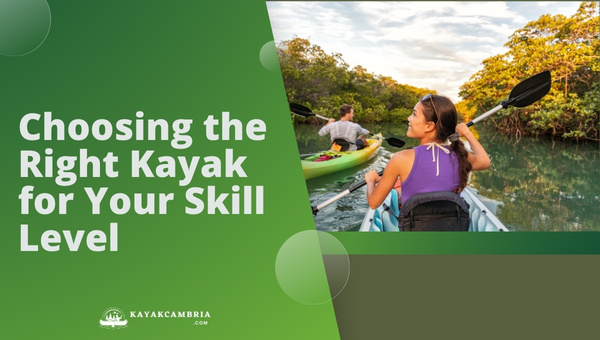
Selecting a kayak that suits your skill level can significantly affect your stability and overall kayaking experience. With numerous designs, models, and specific features available in the market, it’s essential to take your time and make an informed decision before making a purchase. Here’s a guide to help you in your quest to find the perfect kayak that aligns with your skills, experience, and preferences:
Types Of Kayaks
First, it’s crucial to understand the different types of kayaks as they can provide varying levels of stability:
- Recreational Kayaks: These are great for beginners due to their wider hulls, which offer maximum stability and easier maneuverability. Recreational kayaks are often used on calm waters such as lakes, flat rivers, and coastal areas with little to no waves.
- Touring Kayaks: Designed for more experienced paddlers, touring kayaks provide better tracking and cover longer distances more efficiently. They have a narrower hull, which means they can be less stable than recreational kayaks, but they also perform better in rougher waters.
- Whitewater Kayaks: Specifically designed for navigating in fast-flowing rapids, these kayaks prioritize maneuverability and responsiveness over stability. Therefore, they require a higher level of experience and skill.
Paddling Destinations
Before choosing a kayak, consider your paddling destinations, as different terrains might demand different types of kayaks. For example, if you plan to paddle on calm lakes or gentle rivers, a wider recreational kayak would be more appropriate. On the other hand, if you’re up for more challenging coastal regions or rough waters, a touring or whitewater kayak would be a better fit.
Testing And Expert Advice
An essential part of choosing a kayak is to test out different models that pique your interest and seek guidance from experts or experienced paddlers. Reputable dealers often let customers demo their kayaks before purchasing, enabling them to find the right balance between stability, speed, and comfort. Don’t hesitate to ask for advice and recommendations from instructors, fellow kayakers, or sales associates, as they can share valuable insights from their experiences.
Taking the time to select a kayak that complements your skill level will not only improve your stability but also enhance your overall kayaking experience. Remember to consider the types of kayaks, and your paddling destinations, and seek expert advice before making a decision. With the right kayak, you’ll be well-equipped to handle anything the water throws your way.
Building Confidence In Your Kayak Stability
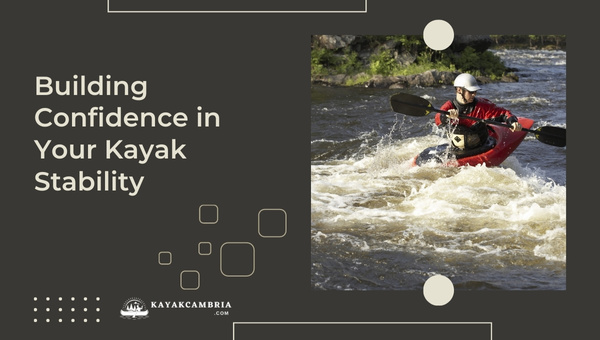
As you progress in your kayaking journey, building confidence in your kayak’s stability is an essential part of improving your skills and gaining more control over your paddling experience. Here are some key aspects to help you work on boosting your confidence:
Start Slow And Give Yourself Time To Adjust
The first and foremost suggestion is to give yourself time to get familiar with your kayak. Start in calm waters with minimal currents and gradually move on to more challenging conditions as you grow more comfortable. This careful progression will allow you to become acquainted with your kayak’s performance in different situations.
Gradually Test Your Kayak’s Limits
As you paddle in varied conditions, begin to test your kayak’s limits by deliberately leaning from side to side or attempting low brace and high brace maneuvers. This practice will help you understand the balance point of your kayak and prepare you for unexpected events in the water.
Practice With A Buddy Or In A Group
It can be reassuring to have someone more experienced or familiar with kayaking when you’re trying to build confidence on the water. Paddle alongside a trustworthy friend or join a kayaking group that shares your enthusiasm for the sport. Not only will this make your kayaking experiences more enjoyable, but it will foster a sense of camaraderie and support.
Take Kayaking Lessons Or Workshops
Consider enrolling in a kayaking course or workshop to refine your skills and gain expert advice. Professional instructors can teach you valuable techniques and safety measures from their years of experience, ultimately giving you the knowledge and skills to handle different kayaking scenarios with more confidence.
Keep Track Of Your Progress
One of the most satisfying aspects of kayaking is seeing your skills develop over time. Regularly engaging in kayaking activities and maintaining a record of your experiences will help you acknowledge the progress you’ve made. You could maintain a kayaking logbook, or note important milestones in a diary, to monitor the changes in your technique and confidence.
Remember, building confidence in your kayak’s stability is a gradual process, and it’s important to be patient with yourself. There’s no one-size-fits-all approach to mastering kayaking, so embrace your unique journey and enjoy every moment spent out on the water.
Essential Gear To Enhance Kayak Stability And Safety in 2024
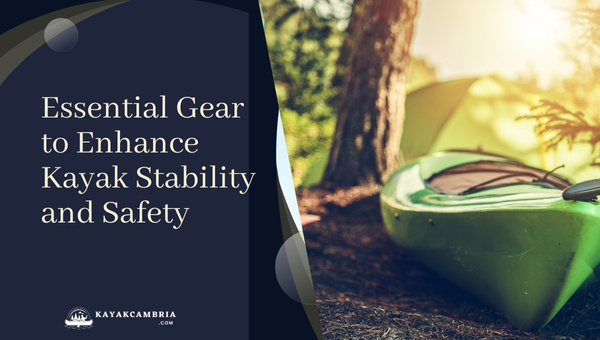
Equipping yourself with the right gear will not only boost your confidence but also significantly improve your kayak’s stability and safety. Here are some crucial items to consider:
1. Personal Flotation Devices (PFDs)
First and foremost, never underestimate the importance of a lifejacket or personal flotation device (PFD). Wearing a PFD ensures your safety in case of a capsize and adds buoyancy, providing extra stability while you paddle.
2. Appropriate Paddle
Choosing the right paddle also plays an essential role in your stability. Different paddles suit different types of kayaking – long touring paddles are better for covering long distances, whereas wider paddles offer more control and maneuverability for whitewater kayaking. Factors to consider when selecting a paddle include its length, blade size, and material.
3. Bilge Pumps And Paddle Floats
If your kayak starts taking on water, bilge pumps help remove excess water from the cockpit to prevent your boat from becoming unstable and ultimately capsizing. A paddle float, on the other hand, is a great self-rescue tool. In case of a capsize, attaching the float to one end of your paddle allows you to use it as an outrigger for added stability.
4. Dry Bags
Secure your belongings in dry bags to protect them from water and ensure that the weight is evenly distributed throughout the kayak, preventing any accidental tipping.
5. Kayak Anchor
A kayak anchor helps maintain your position on the water, which is especially important when fishing or birdwatching. This keeps your kayak stable and prevents it from drifting away due to wind or currents.
6. Kayak Skirts
A kayak skirt keeps water out of your cockpit, especially in rough conditions or when faced with heavy waves. This accessory helps maintain the kayak’s balance, ensuring that water doesn’t accumulate inside the cockpit and cause instability.
Investing in the right gear and accessories can have a significant impact on your kayak’s overall stability and safety on the water. While these items might not prevent a capsize, they can certainly make your paddling experience less stressful and more enjoyable.
The Importance Of Proper Kayak Maintenance in 2024
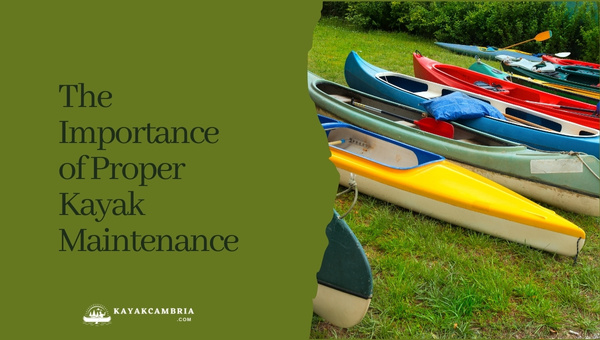
Just like any other piece of equipment, your kayak requires regular care and maintenance to ensure that it remains in top condition and performs at its best. Proper kayak maintenance not only helps to prolong the life of your beloved vessel but also plays a crucial role in maintaining its stability and safety while out on the water. The following are some essential maintenance tips that every kayaker should incorporate into their routine.
Inspect Your Kayak Regularly
Make it a habit to inspect your kayak’s hull, fittings, and overall structure before and after every outing. This way, you can identify any potential issues, wear, or damage that may need immediate attention. Look for scratches, dents, cracks, or any loose parts, and address them as needed.
Repair Damage Promptly
Should you discover any significant damage while inspecting your kayak, it’s essential to repair it as soon as possible. While minor scratches and dents might not immediately impact your kayak’s performance, deeper cracks and damage can compromise its structural integrity and stability. Seek professional assistance for more extensive repairs, or consider using a reliable repair kit for minor issues.
Keep Your Kayak Clean
Regularly cleaning your kayak not only keeps it looking fresh and appealing but also prevents the buildup of dirt, algae, and other organic matter that can affect its performance. Use mild soap and water to clean the kayak thoroughly, and ensure to rinse off any residue. It’s a good idea to do this after every outing, especially if you’ve been paddling in salt water.
Make The Most Of Proper Storage
One of the primary things that can negatively impact the lifespan and stability of your kayak is improper storage. Ensure your kayak is stored in a cool, dry place, away from direct sunlight to prevent UV damage. There are various storage solutions available, such as wall racks, ceiling hoists, or kayak covers. Whenever possible, store your kayak upside down or on its side to avoid any deformation or warping of the hull.
Be Mindful Of Transportation
Another crucial aspect of kayak maintenance is proper transportation. Make sure to use appropriate kayak carriers and racks that fit your kayak’s design and protect it from potential damage during transit. Additionally, secure the kayak using quality tie-down straps, and double-check to ensure it is tightly fastened without causing any undue pressure or deformation.
By diligently following these kayak maintenance tips, you can not only keep your kayak looking great and functioning optimally but also ensure its stability and safety, giving you continued confidence and peace of mind while out on the water.
Embracing The Adventure And Overcoming The Fear Of Tipping
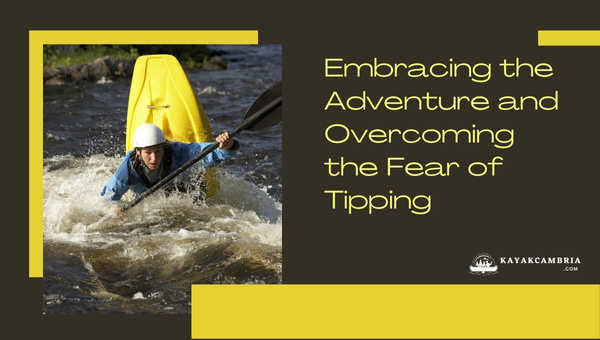
As we venture into the world of kayaking, it’s essential to understand that capsizing is a natural part of the experience. While it may seem daunting, overcoming the fear of tipping can significantly enhance our abilities as paddlers and help us embrace kayaking’s adventurous spirit. Let’s take a closer look at a few ways to gain confidence and navigate the journey with ease.
Adopting A Learning Mindset
Embracing the learning mindset means recognizing that becoming proficient in kayaking comes with trial and error. Capsizing can offer valuable lessons about balance and recovery techniques, making us well-rounded paddlers in the long run. You’ll only become more skilled and confident by accepting that every experience, even a wet exit, is an opportunity to learn and grow.
The Value Of Practicing Techniques
To help conquer the fear of tipping, it’s essential to practice different kayaking techniques that can improve stability and recovery. Start by discovering the proper seating position, mastering the low brace and high brace techniques, leaning into turns, and conditioning your core. Continuously honing these skills will provide you with a strong foundation and significantly reduce your chances of capsizing.
Building Confidence In Controlled Environments
Starting your kayaking adventures in controlled environments, such as calm waters and guided kayaking classes, can help you ease into the sport without feeling overwhelmed. As you gain confidence in your skills and the stability of your kayak, you’ll gradually progress onto more challenging waters, tackling them with increased self-assurance.
Keeping Safety A Priority
Becoming familiar with proper safety gear such as lifejackets (PFDs), the right paddle type, bilge pumps, and paddle floats will ensure that even if you do end up capsizing, you have the necessary tools and knowledge to recover safely. Moreover, reinforcing safety measures will help to ease your anxiety, making the entire kayaking experience more enjoyable.
Finding Support In The Kayaking Community
Building relationships with other kayakers plays a significant role in developing confidence and overcoming the fear of tipping. By joining local kayaking clubs or participating in group outings, you’ll find camaraderie and support from those who share your passion. Plus, you gain access to a wealth of knowledge and experience that can only benefit your paddling adventures.
Capsizing is a natural part of kayaking, but it doesn’t have to define your experience. By embracing a learning mindset, regularly practicing techniques, starting in controlled environments, prioritizing safety, and finding support in the kayaking community, you can conquer your fear of tipping and fully enjoy the thrilling world of kayaking.
Frequently Asked Questions
1. Can kayak stabilizers or outriggers improve stability?
Yes, kayak stabilizers and outriggers can significantly improve the stability of your kayak by providing additional support and balance. They are particularly beneficial for first-time paddlers, those using their kayaks for fishing, or those with limited experience.
2. How do I know if my kayak is stable enough for fishing?
To determine if your kayak is stable enough for fishing, consider the following factors:
1. Hull design: Wider and flatter-bottom hulls offer greater stability suitable for fishing.
2. Weight capacity: Ensure that your kayak can comfortably support you, your fishing gear, and any potential catches.
3. Comfort and outfitting: Accessory mounts, adjustable seating, and ample storage contribute to a comfortable and effective fishing experience.
4. Test it out: Nothing beats trying a kayak yourself to gauge how well it supports your fishing activities.
3. Are inflatable kayaks stable?
Yes, modern inflatable kayaks can be quite stable, depending on their design and quality. High-quality inflatable kayaks are made from durable materials and incorporate stability-enhancing features, such as wider bases and robust air chambers. However, always research and read reviews before purchasing an inflatable kayak to ensure it offers the stability you need.
4. Can children and pets affect a kayak’s stability?
Definitely. Having children or pets aboard your kayak can affect its stability and weight distribution. Always choose a kayak with a higher weight capacity and appropriate seating arrangements to accommodate the additional passengers. Ensure that children and pets wear proper flotation devices and are aware of safety guidelines.
5. Does the length of my paddle affect stability?
The length of your paddle can impact your overall paddling experience. A paddle that is too long or too short may cause you to lean too far while paddling, putting you at risk of tipping. To find the appropriate paddle length, consider your height, kayak width, and paddling style.
6. How does weather affect kayak stability?
Weather elements like wind and waves can impact your kayak’s stability. Heavy winds, strong currents, and choppy waters may cause your kayak to rock or become unsteady. It is essential to be aware of the weather conditions and choose a kayak that offers enough stability for the environment in which you will be paddling.
7. Is it better to sit-in or sit-on-top kayaks for stability?
Both sit-in kayaks and sit-on-top kayaks can provide stability, but each has its strengths and weaknesses. Sit-in kayaks typically offer better secondary stability and are better suited for rough or cold water conditions. On the other hand, sit-on-top kayaks generally have higher primary stability, making them an excellent choice for beginner paddlers and activities like fishing or snorkeling. Ultimately, your skill level, preferences, and planned kayak activities can help you determine which style is right for you.
Conclusion
In the end, the answer to the question “Do kayaks tip easily?” largely depends on the specific kayak, the paddler’s skill level, and the prevailing water conditions. By understanding the factors that affect stability, choosing the right kayak for your needs, and improving your paddling techniques, you can significantly reduce the likelihood of a capsize.
Remember that no matter how stable a kayak may seem, it is important to always wear a lifejacket and have proper safety gear on hand. Practicing self-rescue techniques and taking appropriate kayaking courses can greatly enhance your overall confidence and ability on the water.
As you grow more comfortable and experienced in your paddling adventures, you’ll learn to embrace the occasional challenge of a capsize and even consider it part of the fun. So, gear up, and don’t let the fear of tipping hold you back from enjoying this exciting and versatile water sport!

